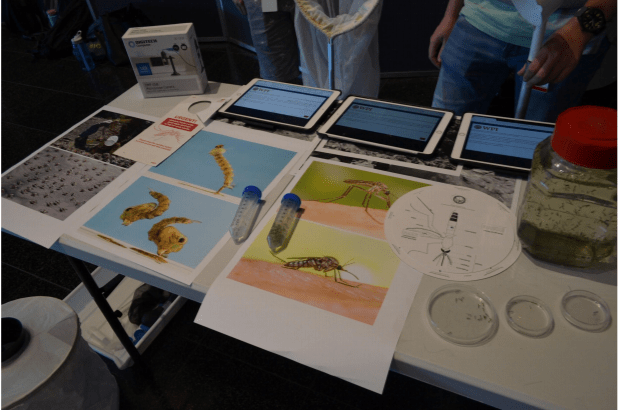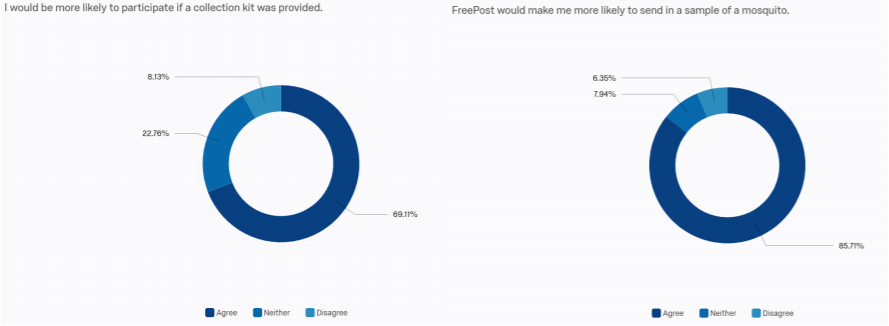Executive Summary
Introduction and Background
New Zealand’s geographic isolation makes its ecosystems especially vulnerable to invasive species and exotic diseases (Jay, 2003). Addressing these biosecurity threats requires the collection of a large amount of data on the distribution and ecology of endemic, introduced, and exotic species in New Zealand that can only be gained through citizen scientist participation. Of New Zealand’s species, our project focuses specifically on mosquitoes due to their potential to harm ecosystems and spread disease if not monitored (Southern Monitoring Services, Ltd., 2018). Our goal was to recommend a collection system and accompanying website to assist citizen scientists submitting physical mosquito specimens to Te Papa’s Mosquito Census. Biosecurity management can intercept exotic species and diseases with the potential to destabilize ecosystems and drive native species to extinction (Brockerhoff, 2009). Native mosquitoes, however, also play important roles in New Zealand’s ecosystems as pollinators and as a vital component of local food chains (J. Kasper, personal communication, February 18, 2019). To protect New Zealand’s ecosystems and public health, mosquitoes must be monitored.
Dealing with biosecurity threats requires the collection, management, and publication of ecological data. In the past, such data was collected solely by scientists, but with the advent of the Internet, citizen scientists are contributing to ecological data collection (Kobori et al., 2016). This ecological data must not only be collected, but be freely accessible, in order to promote research (Michener, 2015).
Te Papa’s Mosquito Census will track and document the distribution of the sixteen mosquito species present in New Zealand. Unlike most animals, mosquito species cannot easily be identified without the use of a microscope (J. Kasper, personal communication, February 18, 2019). For this reason, the Mosquito Census will rely on citizen scientists to submit physical specimens for mosquito specialists to identify. This data will allow Te Papa to not only track endemic and introduced species’ geographical distribution, but also to potentially discover and respond to exotic arrivals before they can establish themselves.
Methodology
We interviewed mosquito specialists and professionals from iNaturalist, NZBEL, Find-A-Pest, the Mückenatlas, the University of Otago, the New Zealand Ministry for Primary Industries, and the New Zealand Ministry of Health. We worked closely with domain experts within Te Papa specializing in public programming, exhibitions, graphic design, marketing outreach, creative development, digital channels, and resource management. Interview feedback and suggestions were used to rule out existing input portals, improve the specimen submission form, construct a list of system requirements for the website, and evaluate the feasibility of identification numbers for submissions. Insight from our interviews was also used to formulate ideas for marketing the Mosquito Census to a larger audience, decide how to transition website development, consider a public health perspective, and identify potential sources of funding. These suggestions were also considered in addressing logistics, privacy, sensational media, and marketing and outreach.
We surveyed museumgoers at a temporary exhibit before opening the survey up to Reddit and Twitter users. Respondents shared information on demographics, their knowledge pertaining to biosecurity and mosquitoes in New Zealand, the Mosquito Census website interface, and their likelihood to participate in the Mosquito Census.
Figure VII.1: Our temporary exhibit
We designed a website for the Mosquito Census. The front-end focused on user interactions and graphic design choices while informing visitors about the project. The back-end consisted of the underlying system responsible for recording, storing, cataloging, uploading, and accessing mosquito specimen records. At a second temporary exhibit, we informally interviewed and observed museumgoers as they navigated the Mosquito Census interface and examined the online submission form to obtain feedback to assess the front-end and the functionality of the website.
Results
From our interviews with mosquito specialists, we refined our recommendations for the specimen submission process. We found the estimated maximum number of identifications possible to be ten identifications per specialist per day. We also determined what fields need to be present in the submission form to ensure the usefulness of the data collected. We found that the majority of survey respondents would be more likely to participate in the Mosquito Census if they were provided collection kits and could utilize FreePost as seen in Figures VII.2 and VII.3
Figures VII.2 and VII.3: Combined online and in-person survey responses
We also determined that no existing platform satisfies the needs of the Mosquito Census. While iNaturalist does not satisfy the input portal and back-end database needs of the Mosquito Census, this platform provides a way for the data that is collected and identified through the Mosquito Census to be shared with an existing citizen science community. Publicizing Mosquito Census data on iNaturalist is both possible and achieves our goal of making ecological data easily accessible to all.
We discussed methods of marketing the Mosquito Census with experts from Te Papa. Our surveying showed a lack of public knowledge about mosquitoes. Approximately one-third of survey respondents supported the eradication of all mosquito species, underscoring a lack of awareness of the benefits of native mosquito species. Due to this misconception, we analyzed different ways of elevating mosquito literacy while also promoting the Mosquito Census. These include lesson plans for teachers, a mention of the Mosquito Census in the upcoming natural history exhibition, and articles on the Te Papa website. Finally, researchers from the Mückenatlas advised us on how to maintain a positive image and encourage participation in the Mosquito Census.
We created a website prototype addressing requirements derived from our surveys and interviews. It contains information about New Zealand’s mosquitoes, a map of previous specimen submissions, and details about the collection and submission process. It also has both a paper and online submission form with the fields required by the Mosquito specialists.
Recommendations
Based on our results, we are recommending that Te Papa utilize the website interface for the Mosquito Census that was created by our team.
After conducting user testing, we recommend that the prototype be modified for the next version created by the museum to reduce confusion for users. These changes include a menu bar on the top of the site or a sidebar that shows users their progression through the website as well as the removal of the arrows on the front page.
Since free sharing of data is one of the goals of our sponsor, we recommend constructing the website in a way that makes collaborating with third parties easier. We specifically recommend sharing the Mosquito Census data with iNaturalist, as their platform corresponds with the structure of our website. We also included a map in the design of the website. We suggest that this function remains on the website so that citizen scientists can see the data directly on the finished Mosquito Census website.
Based on survey results, we are also recommending that the Mosquito Census utilize FreePost, drop-off locations, and collection kits. Implementing these would help decrease barriers of participation for citizen scientists. In addition, our results showed that citizens generally lack knowledge of mosquitoes and their importance in the ecosystem. Therefore, we recommend that Te Papa continue to spread awareness for the project as well as the importance of mosquitoes through public outreach and exhibitions. We are recommending an exhibit design to be featured in the new nature exhibition opening this year. We are also recommending that the public outreach team conduct school visits and share a curriculum that can be used in schools or in homeschooling that can teach children about the importance of mosquitoes and call out for submissions to the Mosquito Census.
Since exotic mosquitoes are a health and safety risk, we recommend that all information provided on the Mosquito Census be checked over by Ministry of Health (MoH) and Ministry for Primary Industries to xv ensure it would not cause panic amongst New Zealand citizens. In the case that any media outlet does write a sensational or falsified story on the Mosquito Census, we recommend that the MoH and Te Papa communications teams work together to make a plan for responding to the media.
Conclusion
The goal of our project was to help Te Papa gather data on the distribution and ecology of New Zealand’s mosquito populations. We recommended an intuitive collection system and accompanying website interface to enable the submission of physical specimens to mosquito specialists. Through interviews and surveys, we determined that the Mosquito Census website and online submission form will be the most effective method to gather data on and amass collections of New Zealand’s mosquito populations. This will assist in future entomology research and public outreach, future citizen science natural history data collection projects, as well as help prevent or effectively respond to potential mosquito-related biosecurity problems




